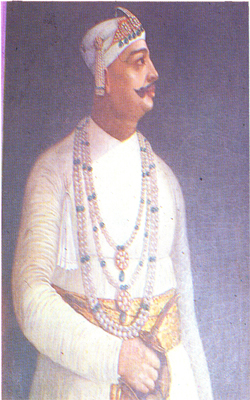
|
|
|
Mir Akbar
Au Khan Sikander Jah was born on 11th November 1768. After the death of Nizam Au
Khan he became the Subedar of the Deccan on 1 lth,August 1803. The succession of
Sikander Jah was ratified by the Emperor Shah Alam II and he also conferred all
his father’s titles on Sikander Jah. The Governor General presented agreements and
treaties which were entered into during the time of his father to Sikander Jah.
On 15th December, 1803 Nawab Sikander Jah concluded a fresh treaty confirming the
existing treaties. In 1804 an article was added to the treaty concluded in 1800
by which it was mutually agreed that in times of war all forts and territories belonging
to the allies would be available to the armies of the allies and officers of the
allies would help in the wars. As a result of the victory in the second Maratha
war, Sikander Jah gained territories between the Ajanta Hills and River Godavari
and also the districts ceded by the Raja of Nagpur west of the Wardha river.
This included the whole of Berar. On 9th May, 1804 Minister Arastu Jah passed away
after serving the State for 30 years and Raja Rajindra took over as the Minister,
in 1804 Mir Alam was appointed as the Minister on the recommendation of the British.
Raja Chandulal was appointed as Assistant to Mir Alam, with the responsibility of
improving the finances, of the Dominion. Mir Alam maintained amicable relations
between the Nizam and the British but he died in 1808 after serving for four years.
Sikander Jah wanted to appoint Munir-ul-Mulk, son-in-law of Mir Alam, as Diwan but
the British disapproved the choice. However a compromise was reached and Muniru
l-Mulk was ultimately made the Diwan but with limited powers.
Raja Chandulal was the favourite of the British and he was made the Peshkar with
real powers. This arrangement continued till the death of Munir-ulM ulk in 1832.
His Highness was not very happy with the administration of Raja Chandulal and wanted
to replace him but the Governor General intervened and said that the removal of
Raja Chandulal would result in strained relations between the Nizam and the British.
British influence in the appointment of ministers brought about chaos in the administration
and led to a feeling of estrangement between the Nizam and the British. In 1812,
Henry RusseLL, with full support and consent of Raja Chandulal, raised an army in
a locality known as Gunfoundry. This army was commanded by British officers and
started with two thousand soldiers. In six years the strength was raised to seven
thousand soldiers. it was known as Russell Brigade after Henry Russell who was the
Resident (18 11- 1820). Subsequently this army became a Contingent and in course
of time drained the Nizam’s finances resulting in a financial crisis.
This financial crisis lasted throughout Raja Chandulal’s administration for about
32 years. Raja Chandulal adopted corrupt means in order to maintain himself in office.
There was no treaty or agreement between the Nizam and the British for the maintenance
of the Contingent. It was by an understanding between Henry Russell and Raja Chandulal.
It was the Nizam’s Contingent only in name; for all practical purposes it was the
British Contingent maintained by the Nizam. To overcome the financial crisis Raja
Chandulal borrowed in 1816 Rs. 36 lakh from a private banking house known as William
Palmer & Company at 25% interest. The owners of this company were the sons of General
Palmer and Lala Banki, the latter one of the partners of the firm. Palmer & Company
was also trading in timber and cotton.
In 1823 His Highness’s Government owed Rs. 78 lakh to William Palmer & Company and
Rs. 28 lakh to the Companies Government. Later from the accounts of the company
it was discovered that the Nizam’s Government was exploited by Palmer & Company
which was in alliance with Raja Chandulal. From 1820-1825 Sir Charles Metcalfe was
the Resident and he informed his Government that the Contingent was not necessary
and the Nizam was not deriving any benefit from the Contingent. He was surprised
to note that the Residency officers were involved in the financial dealings between
the Nizam and Palmer & Company.
Therefore to overcome this financial crisis Sir Charles Metcalfe recommended to
his Government to pay one crore seven lakh rupees to Palmer & Company on behalf
of the Nizam. A treaty was signed. The debts of Palmer & Company were settled and
the Nizam lost a large territory in lieu of the payment. The Nizam waived the Peshkash
(tribute) of Rs. 7 lakh per annum, which the company was paying on account of Northern
Circars. Expenses of the army remained unchanged and finally it came to be known
as the “Hyderabad Contingent”. Metcalfe made the following comments on the Contingent:
“The existence of a force paid by a native state but commanded by our officers and
entirely under our control, is undoubtedly a great political advantage. It is an
accession to our military strength at the expense of another power and without cost
to us; an accession of military strength in an empire where military strength is
everything.
The advantage is immense, but I cannot say that I think the arrangement is a just
one towards the native state. The same circumstances which make it so advantageous
to us make it unjust to the state at whose expense it is paid.” The death of his
favourite daughter in 1826 gave Sikander Jah a great shock that slowly led to his
death on Thursday 21st May, 1829. He was buried in the Royal cemetery of Mecca Masjid.
He was survived by 9 sons and 10 daughters. His eldest son, Nawab Farkhunda Ali
Khan, succeeded him. Secunderabad was named after Sikander Jab.
|
|